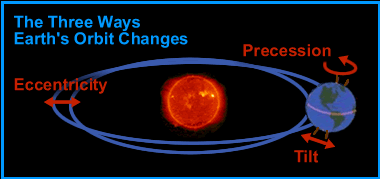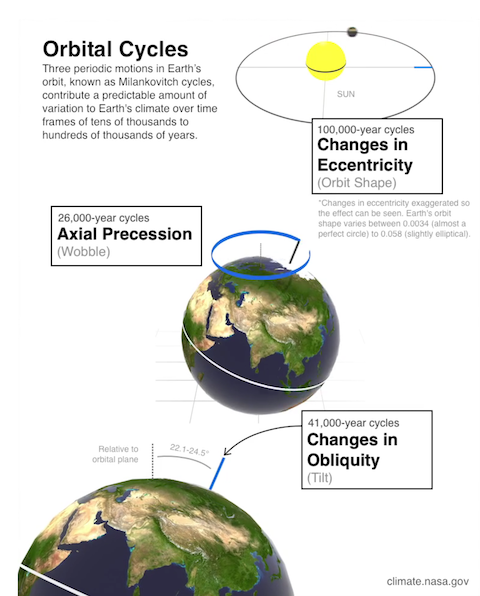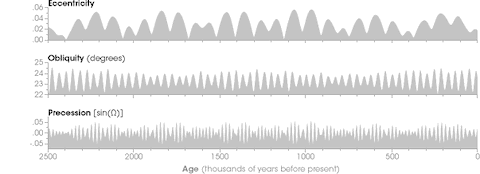
It’s easy to imagine Earth’s orbit as a circle around the Sun. But in truth, its path is more complicated.
In AD 127, the Greek astronomer Hipparchus compared star maps made centuries before to his own maps–and found the stars were in different places.
He realized that Earth must be slowly wobbling on its axis like a top wobbles as it spins, causing it to be oriented differently to the stars.
He called this precession, which happens on a 26,000-year cycle.
In 1500, Copernicus put forth the idea that planets circled the sun.
But 100 years later, Johannes Kepler’s calculations would not match a circular orbit, so he tried an ellipse… and suddenly things lined up, establishing elliptical orbits for planets.
Later astronomers calculated that these elliptical orbits also vary—from nearly circular to much more oblong—as they’re influenced by the gravities of other planets.
These eccentric orbits cycle at intervals of about 100,000 and 400,000 years.
This change in tilt, called obliquity, combines with Earth’s wobble and eccentric elliptical orbit to dramatically impact the amount of sun the planet receives.
We’ll talk about why this matters in another EarthDate.
Background
Synopsis: Earth’s daily rotation and annual orbit around the Sun may seem stable to us, but over very long periods of time, they change cyclically. Their combined variation influences the amount of sun that reaches different parts of Earth’s surface, and it is predictable.
- Milanković cycles are named after Milutin Milanković, the scientist who first modeled the ways they interact to impact Earth’s climate.
- Every 100,000 years, Earth’s orbit stretches from nearly circular to slightly elliptical and back. Every ~400,000 years, this change in eccentricity is even more pronounced.
- Every 41,000 years, Earth’s axis tilts 2.4 degrees more toward the sun; the obliquity then cycles 2.4 degrees away from the sun.
- And every 26,000 years, Earth completes a wobble on its axis, known as precession.

- Eccentricity: In 1609, Johannes Kepler published his first two laws of planetary motion in Astronomia Nova, establishing the elliptical orbit of planets around the sun.
- The previous heliocentric view, developed by Copernicus in the 1500s, stated that planetary orbits were circular. The orbits of Venus, Neptune, and Earth are nearly circular, but the orbits of Mars and Mercury are not.
- After trying unsuccessfully for 2 years to fit a circular orbit with complicated retrograde “epicycles” to Mars, Kepler tried an ellipse, and this simpler approach worked. His first and second laws of planetary motion state that planetary orbit is an ellipse, and the Sun is at one of the ellipse’s focal points. Eccentricity of zero results in a circle, and orbits become more elliptical as they increase toward 1.
- Subsequent scientific studies showed that Earth’s orbital eccentricity varies from nearly circular (e = 0.000055) to a maximum ellipticity of 0.0679, which is just still just barely elliptical.
- Caused by the gravitational tug of other planets, like Jupiter, Saturn, and Venus, Earth’s eccentricity has several periodicities. The main ones are ~100,000 years and 405,000–413,000 years.
- Today, the Earth’s orbital ellipticity is nearly circular at 0.0167, but that still causes 6% more insolation during Earth’s closest approach to the Sun than when it is farthest away.
- In ~200,000 years, when Earth’s orbit is at its most elliptical point, the difference in insolation between the closest and farthest approaches will be around 23%. In a previous episode, we explained how eccentricity impacts Earth today.
- Obliquity: In 1904, German scientist Ludwig Pilgrim showed that a third cycle impacted Earth’s orbit: a variation in the tilt of the planet’s axis from 22.1 to 24.5 degrees every ~41,000 years.
- Earth’s axis is tilted because of the distribution of landmass on the planet, which makes the Northern Hemisphere top-heavy.
- When Earth’s axis is more upright with a lower angle of tilt, the poles receive less solar radiation.
- Higher angles of tilt result in more extreme seasons on Earth, with colder winters and hotter summers, including higher insolation at the poles.
- Milanković reckoned that, more than winter temperatures, cool summer temperatures in high latitudes helped snow to last and were the key to the growth of ice sheets. He correctly deduced that high-latitude summer radiation curves correlated with geological evidence of ice ages.
- Today, Earth’s axial tilt is 23.44 degrees. It was last at its maximum in 8700 BC and is currently decreasing toward a milder minimum in about 9800 years.
- Precession: In AD 127, the Greek astronomer Hipparchus—also known as the father of trigonometry—discovered that star maps made centuries earlier during the autumnal equinox did not agree with star maps of his time.
- The equinoxes appeared to be moving, or precessing, through the constellations of the zodiac.
- He confirmed this by comparing the time it took between equinoxes (the tropical year) and the time it took for the Sun to return to the same place with respect to the stars (the sidereal year).
- This mismatch is caused by the wobble of Earth’s axis, which is like the wobble of a child’s spinning top. It means that in the future, Polaris will no longer be the North Star—Earth’s axis will be pointing elsewhere.
- Hipparchus’ original calculations were much less precise, but today’s calculations suggest precession has a period of 25,771.5 years.
- The three cycles have different time scales.
- Milanković knew that at times, these cycles would interact constructively to boost insolation, and at other times they would interfere destructively to diminish it.
- He set about to quantify the effect using mathematical modeling, which we will discuss further in the next EarthDate.


